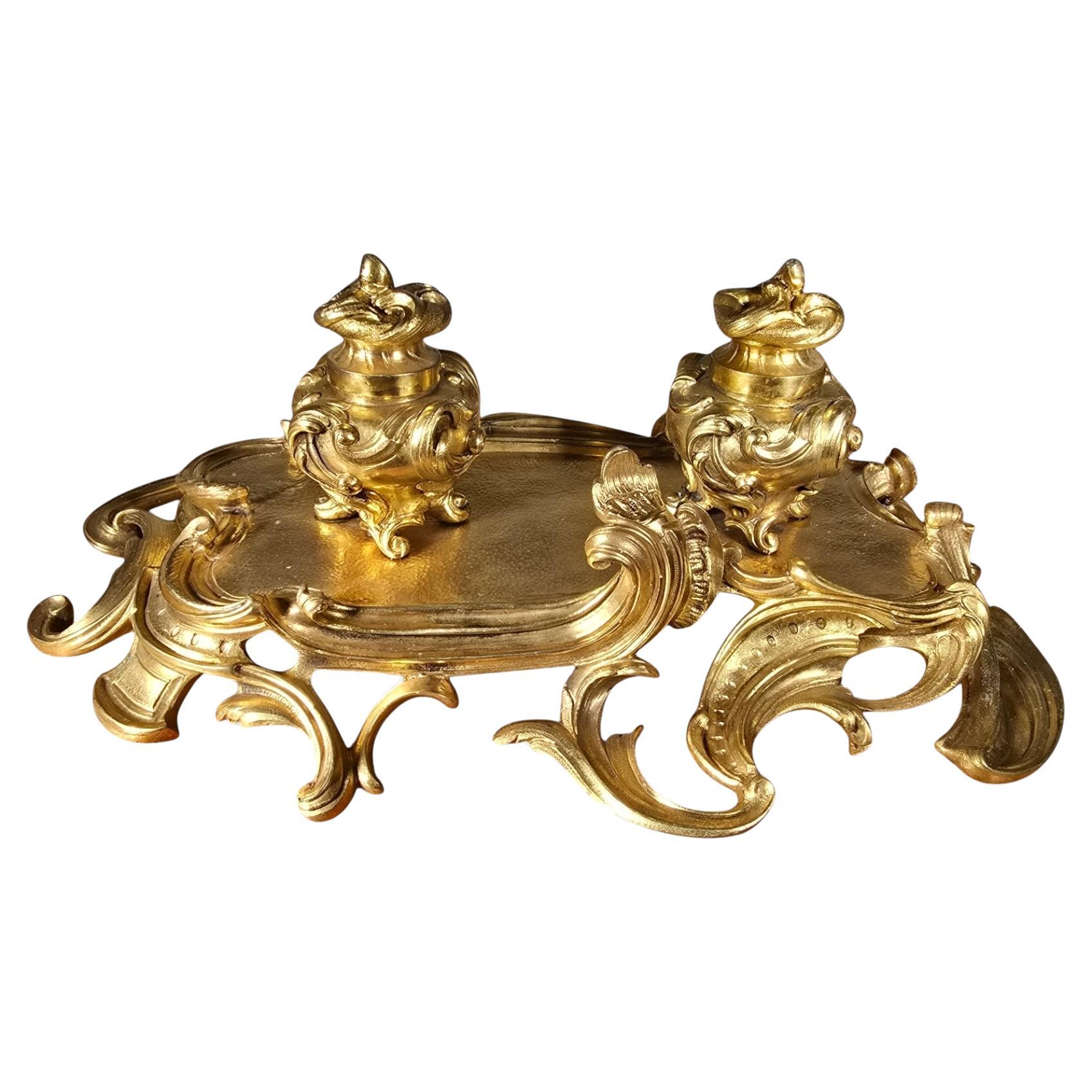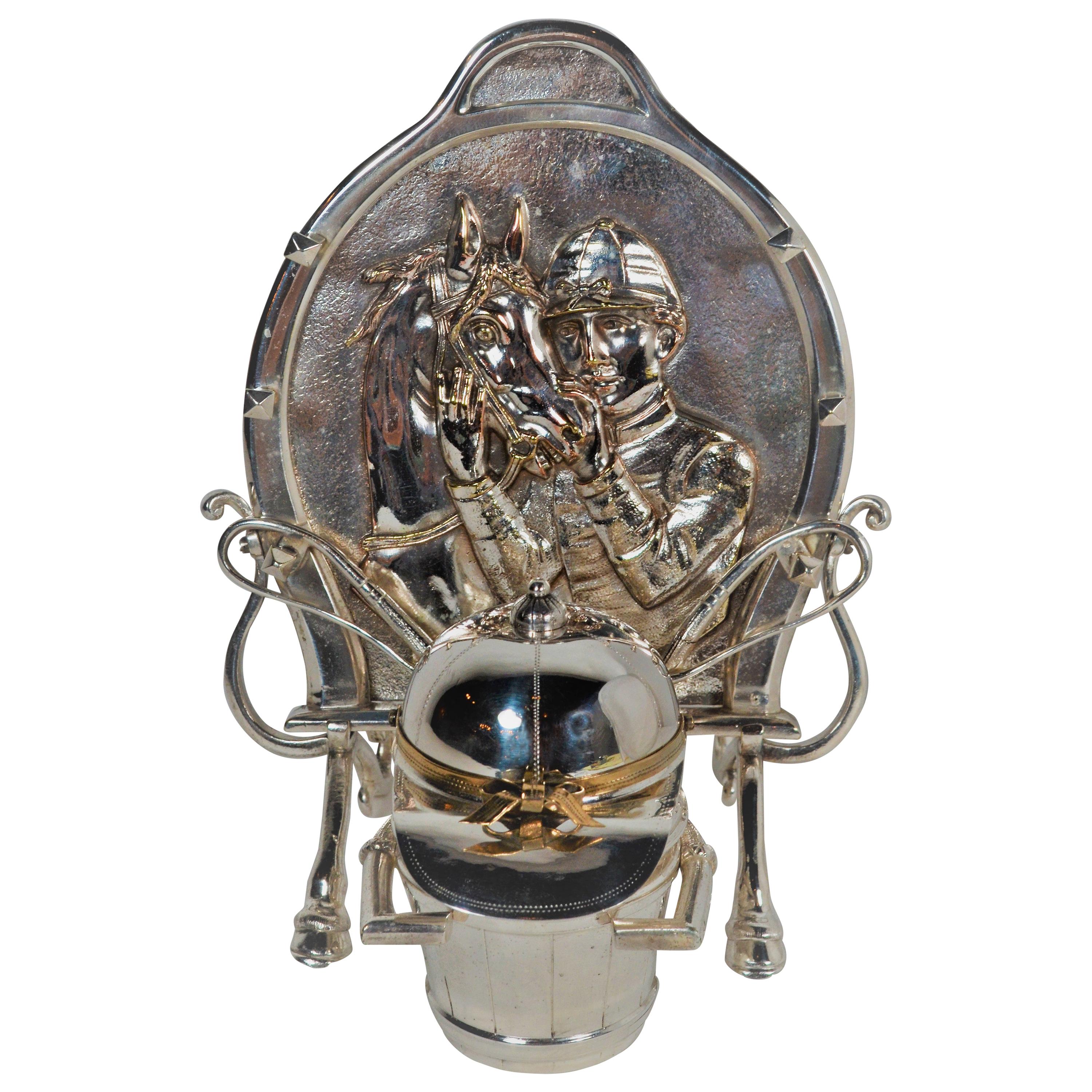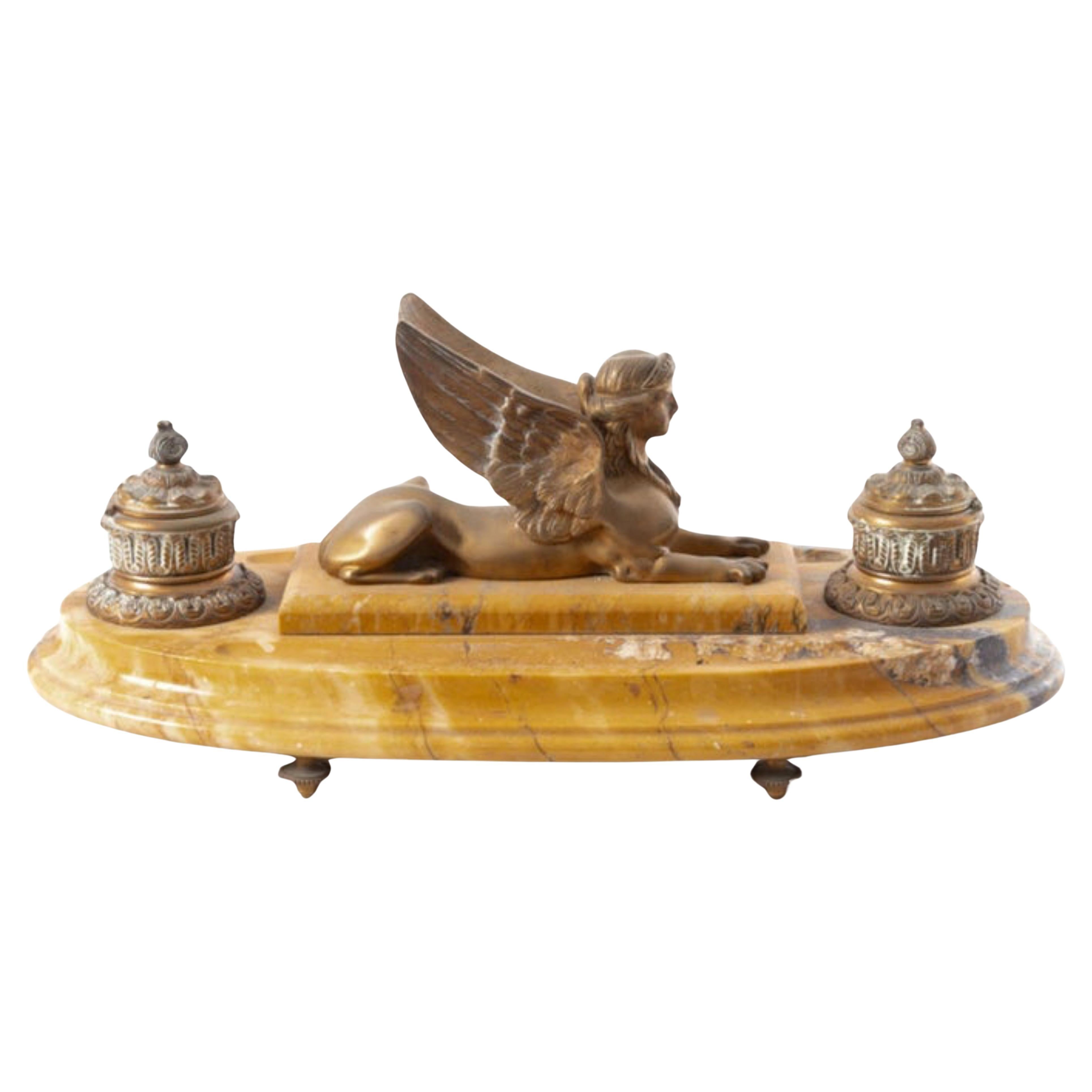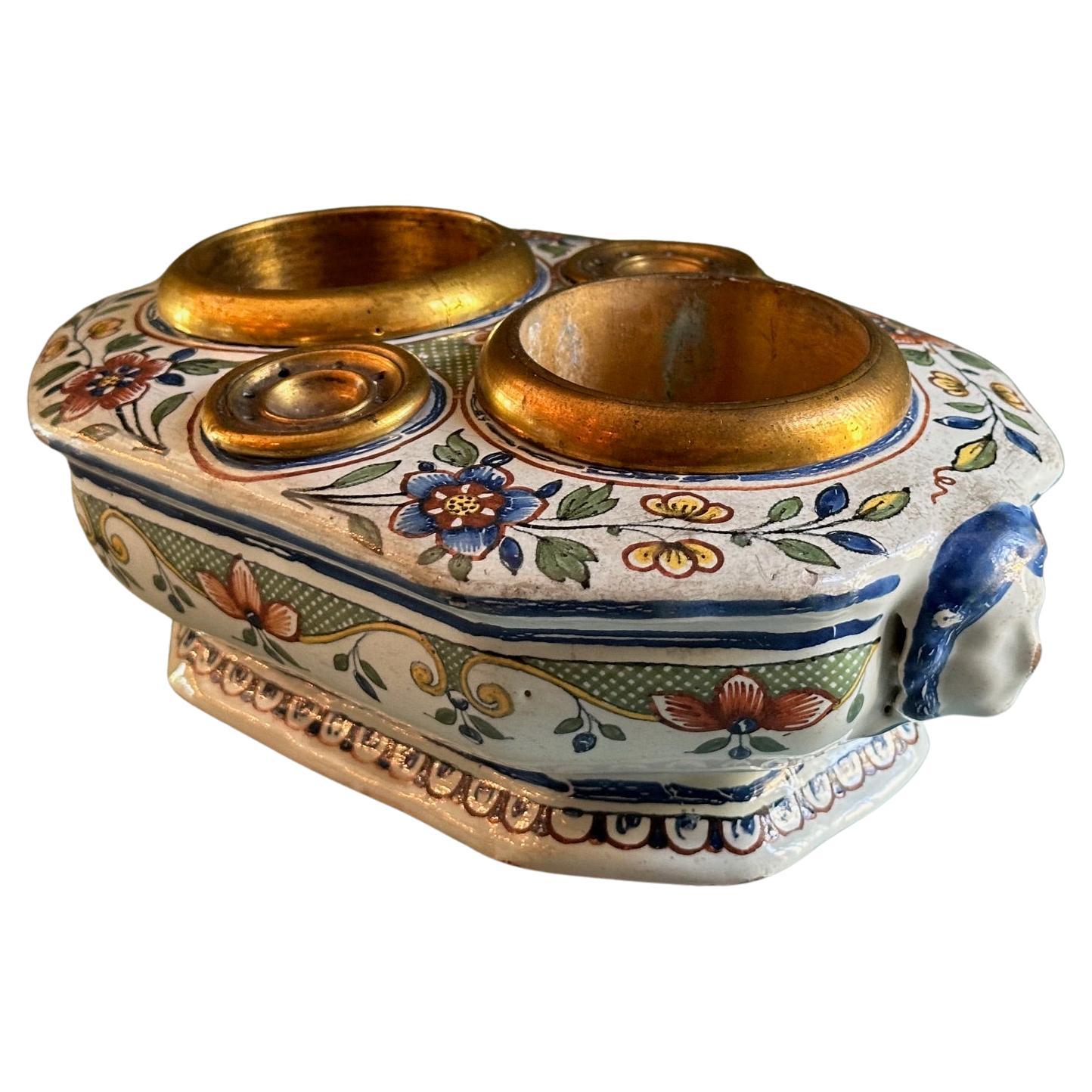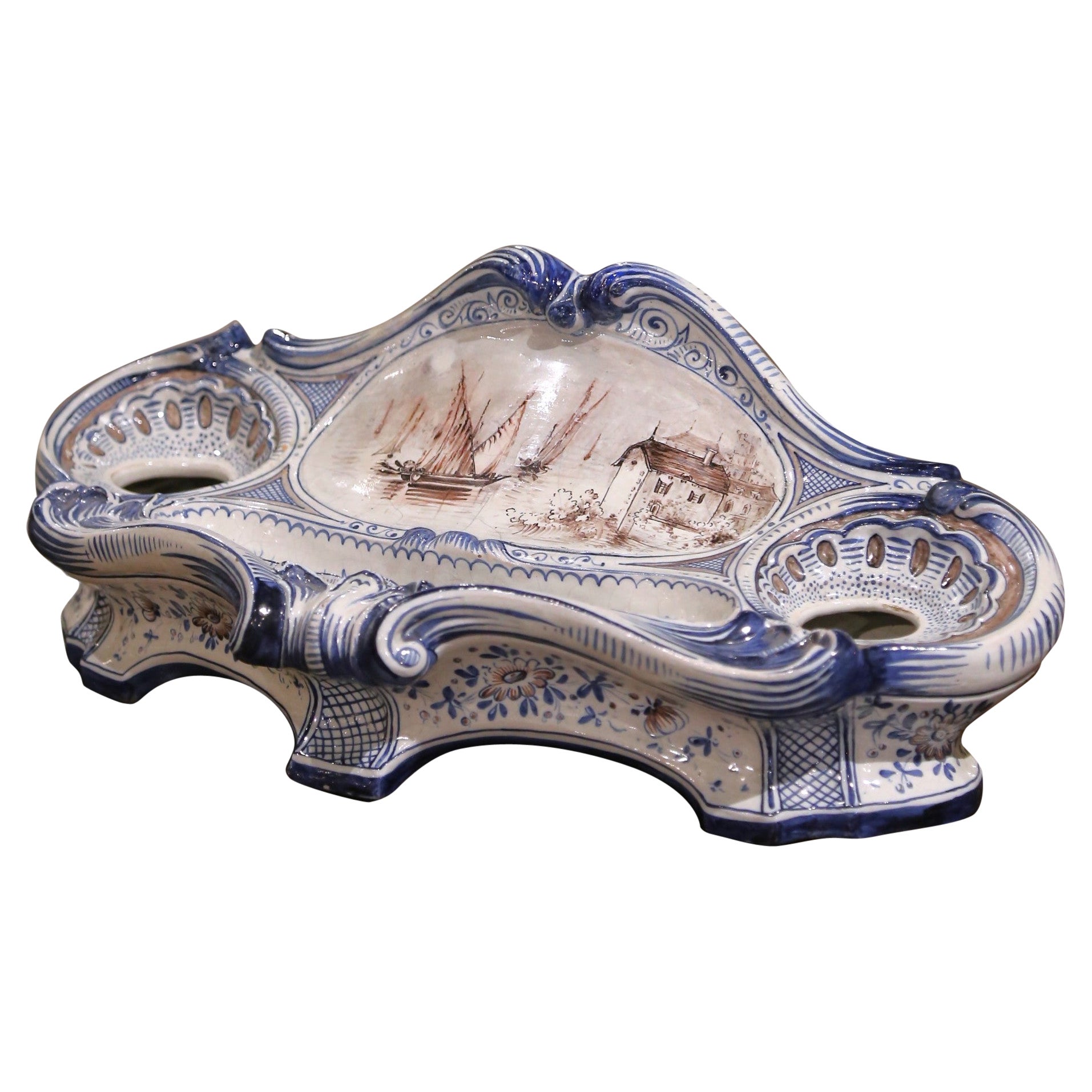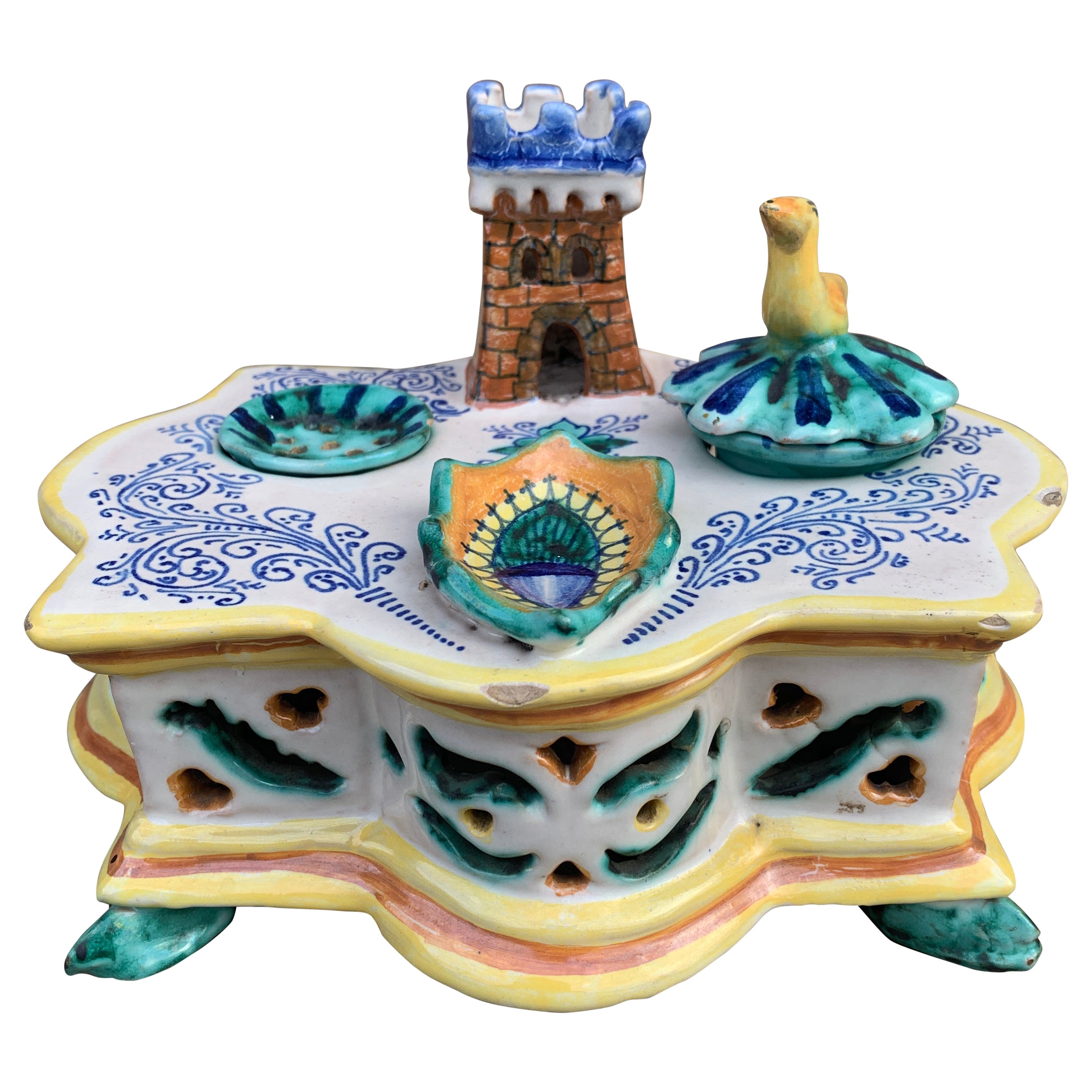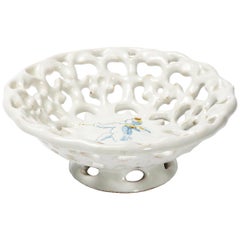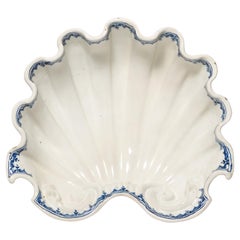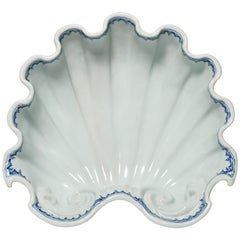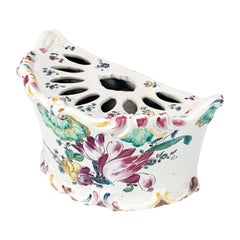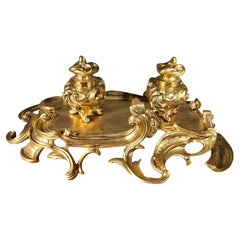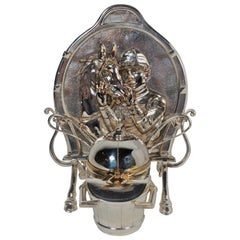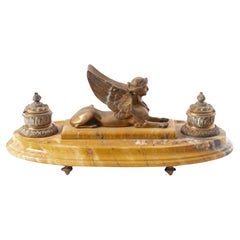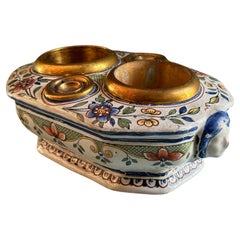Items Similar to Renaissance Inkwell Calamelli workshop, Italy, Faenza, second half of the 16th
Video Loading
Want more images or videos?
Request additional images or videos from the seller
1 of 20
Renaissance Inkwell Calamelli workshop, Italy, Faenza, second half of the 16th
$19,198.94
£14,158.47
€16,000
CA$26,513.56
A$29,091.69
CHF 15,225.24
MX$358,020.17
NOK 191,815.15
SEK 179,663.47
DKK 121,859.66
About the Item
Inkwell
Calamelli workshop (attr.).
Faenza, second half of the 16th century
Height 4.33 in; length 8.07 in; depth 2.95 in (11 cm; 20.5 cm; 7.5 cm)
Weight: 0.800 lb (363 g)
State of conservation: some chipping to the top of the mask around the mouth. Handle glued, without any restorations; minor chips in some raised areas.
This object has the shape of a foot wearing Greek-style footwear, as can be seen in some raised areas. The foot is anatomically modeled with bare toes, while the ankle is partially covered by the footwear. On the heel, there is a small circular handle to support the object. The mouth of the container is shaped like a mask. The interior, completely enameled, suggests that the piece was intended to be used as an inkwell or to contain some other liquid. The base, however, is not enamelled.
The painted decoration, scant and brief, consists of rapid cobalt blue shading between the toes of the foot, with more precise emphasis on the nails. It is accompanied by yellow citrine accents to enhance the forms. The mask is painted with the tip of the brush, to accentuate the tense nature of the eyes and to accentuate their outline. Thin strokes of yellow-orange line the interior of the mouth.
Since the Renaissance, this decoration has been referred to as "compendiaria" and it characterizes the period of production extending from the mid-16th century to approximately the middle of the following century. It significantly influenced tastes at the time. It evolved from the polychrome style "istoriato" and transformed into a new style that "summarized" (compendia), or condensed, the ornamentation of the works into a few colors, placing greater prominence on the shapes. It was often inspired by metal specimens. Since the Renaissance, this decoration has been referred to as "compendiaria" and it characterizes the period of production extending from the mid-16th century to approximately the middle of the following century. It significantly influenced tastes at the time. It evolved from the polychrome style "istoriato" and transformed into a new style that "summarized" (compendia), or condensed, the ornamentation of the works into a few colors, placing greater prominence on the shapes. It was often inspired by metal specimens.
This artwork finds parallels in similar objects all characterized by this refined style and produced in the city of Faenza and other Italian centers starting from the mid-16th century.
The closest comparable example in majolica is a foot acquired by the British Museum in 2011 (inv. 2011, 8008.1). This was previously published by Carmen Ravanelli Guidotti in 1996 and later by Dora Thornton in 2016 during the conference on Renaissance ceramics in Assisi.
The artwork in the British Museum bears the inscription "VR. FA" underneath the base, associated with Virgiliotto Calamelli. It is characterized by a "compendiaria" decoration that focuses on the form of the footwear adorned with leaves, coloring them in yellow-orange. On the other hand, our foot, which is morphologically very similar, leaves the raised footwear uncolored, shading only certain areas with a watercolor-style effect.
In addition to the painted decoration, the comparison between these two works demonstrates other subtle differences, such as the particularly unique finishing of the ceramics performed upon removal from the mold: notice the mouthpiece, which is oval on our specimen while round on the one from the British Museum. The mask of this latter piece features a pair of goat horns on its head and has a wide hooked nose, curled moustaches, and an uncombed beard. On the other hand, the grotesque face of our foot, which has lost the decoration on its head, has less sculptural features, with a prevalence of textured enamel, clearly visible in the drops of the decoration.
The production style of our maiolica, coupled with the lack of signatures, does not exclude the possibility of a broader attribution to other contemporary Faenza workshops.
In this regard, it is useful to recall how we often find morphologically similar works initialed by different Faenza workshops and how in these areas of production the active craftsmen were numerous, so much so that it is difficult to recognize the various artistic personalities to which individual works can be traced. It is also important to underline how the workshops worked in parallel with the more well-known ones of Calamelli, Mezzarisa, Bettisi, and Utili, all equally engaged in the revolution of taste during the "compendiario" period.
Thus, among the inventory documents, we find detailed lists regarding "credenzas" ordered from the Faenza workshops which have similar forms but bear different signatures. For example, the salt shaker "a dolphin" was produced in both white enamel by the Calamelli and Bettisi workshops and with a "berettino" background by the Utili workshop. (C. Ravanelli Guidotti, Bianchi di Faenza, Ferrara, 1996, p. 210 n. 46 and p. 236 n. figs. 3a-3b).
The exchange of molds among the various workshops is also detectable in a range of works similar to ours in taste and cultural intent: boot-shaped pourers with a mouthpiece in the guise of a lion's head, a form that draws inspiration from pewter or glass models (C. Ravanelli Guidotti, op. cit., 1996, p. 492 n. 140). However, there is a single example known with the signature "Do Pi," which stands for Don Pino, dating between 1570 and 1580, now at Waddesdon Manor (inv. 7119). This fact could suggest that the mold was passed from the workshop of Virgiliotto Calamelli to that of Leonardo Bettisi, also known as Don Pino, when he took over the activity after 1570. (T. Wilson, in L. Hollein, R. Franz, T. Wilson, editors, Tin Glaze and Image Culture The Mak maiolica collection in its wider context, Vienna 2022, p.135, no. 87. D. Thornton, in Giulio Busti, Mauro Cesaretti, Franco Cocchi, editors, La maiolica italiana del Rinascimento: studi e ricerche. Proceedings of the international conference, Assisi, September 9-11, 2016, pp. 66-69).
Regarding the shape of the artwork under examination, the model of inspiration has been the subject of numerous hypotheses put forth by scholars. Maiolica feet are refined and sought-after artifacts that, along with votive bronzes or classically inspired bronzes, characterized a long tradition of imitation during the Renaissance (Warren J. in Marino M., eds., Fabulae pictae: myths and stories in Renaissance maiolica, Florence 2012). This tradition can be attributed to the demand for "antique-style" works as ornaments, alongside ancient originals, for the desks of Renaissance gentlemen. The Faenza potters actively responded to this demand with "the curious predilection of those maiolica makers for strange shapes: hammers, violins, pyramids, clogs and shoes, cages, etc." (G. Liverani A rare heirloom of Faenza majolica. Faenza XL, 1954 fasc. II pp. 30-33). The hypothesis that associates the container with Roman lamps in the shape of a shod foot is particularly convincing: these were widespread in the first two centuries AD and possibly connected to the oriental cult of Serapis.
Moreover, the functionality of these works varied depending on the choices of details applied to the molds, which could alter their use. An example that testifies to this is a maiolica foot from Deruta, adorned with stigmas, wearing a flat-soled sandal with a wide-open mouth-shaped spout and equipped with a hole for the liquid to flow out from the tip of the big toe. This characteristic is more consistent with a "Trick cup" or "drink if you can" cup, despite the comparable artwork, which passed through the antique market (C. Ravanelli Guidotti, op. cit., 1996, p. 546 n. 168). It recalls, as a source of inspiration, a golden bronze lamp in the shape of a foot at the Correr Museum in Venice (XI,102), probably by Andrea Biosco, also known as Riccio (G. Mariacher, Bronzetti veneti del Rinascimento, Vicenza 1971, pp.28, no. 73, fig. 73). The same model is found with variations in two Deruta pieces from the Campana collection at the Louvre: the first foot with an outlet hole on the heel (Inv. OA 1823) can be interpreted as a Trick cup, and the other one, with a more sober shape, can be used as an inkwell (Inv. OA 1242).
Our simple and unadorned foot, as well as the one at the British Museum, is likely intended for use as an inkwell. The very simplicity in execution, despite the lack of signatures, suggests an attribution to the Faenza workshop of Virgiliotto Calamelli, supported by archival documents containing inventories of the workshop, published by Grigioni in 1934. In these inventories, dated 1556, among the listed items of various forms, "2 piedi" (2 feet) are mentioned, clearly referring to the presence of two examples of such shape in the workshop.
In any case, this artwork belongs to the context of learned curiosities typical of the late Renaissance period, many of which find ample expression in the exquisite Faenza productions. These productions were strongly engaged in the great revolution of taste represented by the "whites" (D. Thornton 2016, op. cit., pp. 69-80).
Bibliography:
C. Ravanelli Guidotti, Bianchi di Faenza, Ferrara, 1996, p. 128 n. 20;
D. Thornton, in Giulio Busti, Mauro Cesaretti, Franco Cocchi, editors, La maiolica italiana del Rinascimento: studi e ricerche. Proceedings of the international conference, Assisi, September 9-11, 2016, pp. 63-82;
C. Grigioni, Documenti... I C. maiolicari..., in Faenza, XXII (1934), pp. 50-54, 88-90, 143-153;
Warren J. in Marino M., editor, Fabulae pictae: myths and stories in Renaissance majolica, Florence 2012;
G. Mariacher, Bronzetti veneti del Rinascimento, Vicenza 1971, pp.28, no. 73, fig. 73;
G. Liverani A rare heirloom of Faenza majolica. Faenza XL, 1954 fasc. II pp. 30-33;
T. Wilson, in L Hollein, R. Franz, T. Wilson, editors., Tin Glaze and Image Culture The Mak maiolica collection in its wider context, Vienna 2022, p.135, no. 87;
G. Vasari, Le vite de' più eccellenti pittori, scultori e architettori, 1568.
- Attributed to:Virgiliotto Calamelli (Workshop/Studio)
- Dimensions:Height: 4.34 in (11 cm)Width: 8.08 in (20.5 cm)Depth: 2.96 in (7.5 cm)
- Style:Renaissance (Of the Period)
- Materials and Techniques:Maiolica
- Place of Origin:
- Period:16th Century
- Date of Manufacture:Circa 1570
- Condition:Repaired: Handle glued, without any restorations. Wear consistent with age and use. Minor losses. Some chipping to the top of the mask around the mouth. Handle glued, without any restorations; minor chips in some raised areas.
- Seller Location:Milano, IT
- Reference Number:1stDibs: LU4352237965332
About the Seller
4.3
Vetted Professional Seller
Every seller passes strict standards for authenticity and reliability
Established in 1860
1stDibs seller since 2018
21 sales on 1stDibs
Associations
International Confederation of Art and Antique Dealers' Associations
- ShippingRetrieving quote...Shipping from: Milano, Italy
- Return Policy
Authenticity Guarantee
In the unlikely event there’s an issue with an item’s authenticity, contact us within 1 year for a full refund. DetailsMoney-Back Guarantee
If your item is not as described, is damaged in transit, or does not arrive, contact us within 7 days for a full refund. Details24-Hour Cancellation
You have a 24-hour grace period in which to reconsider your purchase, with no questions asked.Vetted Professional Sellers
Our world-class sellers must adhere to strict standards for service and quality, maintaining the integrity of our listings.Price-Match Guarantee
If you find that a seller listed the same item for a lower price elsewhere, we’ll match it.Trusted Global Delivery
Our best-in-class carrier network provides specialized shipping options worldwide, including custom delivery.More From This Seller
View AllAncient Italian Renaissance Maiolica Crespina, Faenza, 1580 Circa
Located in Milano, IT
Crespina
Faenza, last quarter of the 16th century
Maiolica painted in two colors, light blue and yellow, on a thick, rich layer of white enamel.
It measures 2.24 in (5.7 cm) in height, 6.10 in (15.5 cm) in diameter.
lb 0.55 (kg 0.25)
State of conservation: mimetic restoration.
The small cup has a raised central “umbone”, a perforated brim and a shaped rim. It rests on a high jutting foot. The "crespina" shape, in some inventories is cited as "tacce de frute" (fruit cups). It was particularly appreciated in the Renaissance and has variants based on the formal types and the different sizes. The decoration, made according to the dictates of the “compendiario” style, used few standardized colors: blue and yellow on a thick white and shiny enamel, deliberately chosen as the colour which was most reminiscent of silver. This choice derived from a trend in creative design of the era: the shapes used in the molds were often taken from metal objects. An idea which would last throughout the Renaissance.
The work shows, in the middle of the “umbone”, a winged putto stepping forward while playing a long thin trumpet.
The depiction of the putto is fully representative of the repertoire of the Faenza workshops of the sixteenth century.
Some specimens with this type of decoration have been published in a volume by Carmen Ravanelli Guidotti: there appears the whole productive repertoire of this fundamental moment of transition between the taste for the “istoriato” style and the great simplification of decoration in the “compendiario” period. This style, in its simplicity, however, saw its expression in a rather varied collection of decorative subjects, including old-fashioned busts...
Category
Antique 16th Century Italian Renaissance Ceramics
Materials
Maiolica
Ancient Italian Maiolica Faenza, Ferniani Factory, Circa 1700
By Ferniani Factory
Located in Milano, IT
Centerpiece white maiolica shell
Ferniani factory, early period: 1693-1776
Faenza, circa 1700
Measures: 5.6 in x 14.72 in x 13.46 in (14.3 cm x 37.4...
Category
Antique Early 1700s Italian Baroque Ceramics
Materials
Maiolica
Ancient Italian Maiolica Faenza, Ferniani Factory, Circa 1700
By Ferniani Factory
Located in Milano, IT
Centerpiece light blue maiolica shell
Ferniani factory, early period: 1693-1776
Faenza, 1700 circa
5.5 in x 14.72 in x 13.77 in (14 cm x 37.4 cm X cm 35)
lb 4.40 (kg 2)
State of con...
Category
Antique Early 1700s Italian Baroque Ceramics
Materials
Maiolica
Ancient Maiolica Flower Pot Pasquale Rubati Factory, Milan Circa 1770
By Pasquale Rubati
Located in Milano, IT
Maiolica flower pot “a mezzaluna” decorated with tulip
Pasquale Rubati Factory
Milan, circa 1770.
Measures: 4.7 in x 4.7 in x 8.6 in
12 cm x 12...
Category
Antique 1770s Italian Rococo Ceramics
Materials
Maiolica
Rococo Italian Maiolica Flower Pot Pasquale Rubati, Milano, 1770 circa
By Pasquale Rubati
Located in Milano, IT
Maiolica flower pot “a mezzaluna” with support feet
decorated with little bunches of flowers
Pasquale Rubati Factory
Milan, circa 1770
5.5 in X ...
Category
Antique 1770s Italian Rococo Ceramics
Materials
Maiolica
Ancient Maiolica Cup, Rubati Manufacture, Milan, Circa 1770 - 1780
By Pasquale Rubati
Located in Milano, IT
Sick cup
Pasquale Rubati Manufacture
Milan, Circa 1770 - 1780
Maiolica decorated in polychrome “a piccolo fuoco” (third fire)
It measures: h 2.36 x 7.4 x 7.87 (h 6 x 19 x 20 cm)
...
Category
Antique 1770s Italian Rococo Ceramics
Materials
Maiolica
You May Also Like
French Baroque-Style Inkwell, 19th Century
Located in Madrid, ES
An elegant French inkwell crafted in gilded bronze in the Baroque style from the 19th century. This luxurious piece reflects intricate artistry and opulence, typical of Baroque-inspired decor.
Features:
Material: Solid bronze with a rich gilded finish.
Design: Features ornate Baroque motifs, including scrolling patterns, floral accents, and elegant detailing.
Functionality: Includes compartments for ink wells and a central area for pen placement.
Dimensions:
Length: 40 cm
Width: 22 cm
Height: 15 cm
Highlights:
Artistic Excellence: Exemplifies the grandeur and intricate craftsmanship of 19th-century French design.
Collector’s Item: A fine addition to collections of antique writing instruments...
Category
Antique 1850s Inkwells
Materials
Bronze
Antique English Victorian Inkstand and Pen Holder
Located in New Orleans, LA
Charming little piece
Category
Antique Late 19th Century English Inkwells
Materials
Silver Plate
Inkwell FRENCH MANUFACTURING OF THE EARLY 20th Century
Located in Madrid, ES
Inkwell
FRENCH MANUFACTURING OF THE EARLY 1900s
Empire style inkwell in yellow Siena marble with gilded bronze inkwells and sphinx.
48 x 23 cm Height 20.
Category
Early 20th Century French Napoleon III Inkwells
Materials
Marble
19th C. Antique Writing Stand Desk office Inkwell Center Piece Faience Porcelain
Located in West Hollywood, CA
19th C. Antique Writing Stand Desk office Inkwell Center Piece Faience Porcelain . This beautiful garniture on a desk a table or a console will a...
Category
Antique Early 19th Century European Inkwells
Materials
Brass, Bronze
$3,600 Sale Price
25% Off
19th Century French Louis XV Hand Painted Delft Style Faience Inkwell Vide-Poche
By Delft
Located in Dallas, TX
This uniquely shaped ceramic inkwell was sculpted in France, circa 1880. The cartouche-shaped desk essential features a hand painted black and white center medallion with sailboats, ...
Category
Antique Late 19th Century French Louis XV Inkwells
Materials
Ceramic, Faience
Italian Provincial Deruta Hand Painted Allegorical Faience Inkwell
By Deruta
Located in Elkhart, IN
A beautiful hand painted blue, white, yellow, and green Allegorical faience pottery desk stand inkwell featuring a castle, bird, and foliate designs.
By Deruta
Italy, Early 20th Ce...
Category
Early 20th Century Italian French Provincial Delft and Faience
Materials
Faience, Pottery
